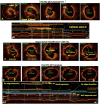Optical Coherence Tomography: An Eye Into the Coronary Artery
- PMID: 35647059
- PMCID: PMC9130606
- DOI: 10.3389/fcvm.2022.854554
Optical Coherence Tomography: An Eye Into the Coronary Artery
Abstract
Optical coherence tomography (OCT) is slowly but surely gaining a foothold in the hands of interventional cardiologists. Intraluminal and transmural contents of the coronary arteries are no longer elusive to the cardiologist's probing eye. Although the graduation of an interventionalist in imaging techniques right from naked eye angiographies to ultrasound-based coronary sonographies to the modern light-based OCT has been slow, with the increasing regularity of complex coronary cases in practice, such a transition is inevitable. Although intravascular ultrasound (IVUS) due to its robust clinical data has been the preferred imaging modality in recent years, OCT provides a distinct upgrade over it in many imaging and procedural aspects. Better image resolution, accurate estimation of the calcified lesion, and better evaluation of acute and chronic stent failure are the distinct advantages of OCT over IVUS. Despite the obvious imaging advantages of OCT, its clinical impact remains subdued. However, upcoming newer trials and data have been encouraging for expanding the use of OCT to wider indications in clinical utility. During percutaneous coronary intervention (PCI), OCT provides the detailed information (dissection, tissue prolapse, thrombi, and incomplete stent apposition) required for optimal stent deployment, which is the key to successfully reducing the major adverse cardiovascular event (MACE) and stent-related morbidities. The increasing use of OCT in complex bifurcation stenting involving the left main (LM) is being studied. Also, the traditional pitfalls of OCT, such as additional contrast load for image acquisition and stenting involving the ostial and proximal LM, have also been overcome recently. In this review, we discuss the interpretation of OCT images and its clinical impact on the outcome of procedures along with current barriers to its use and newer paradigms in which OCT is starting to become a promising tool for the interventionalist and what can be expected for the immediate future in the imaging world.
Keywords: IVUS; OCT; OCT in ACS; OCT in bifurcation angioplasty; OCT in left main bifurcation angioplasty; calcified lesion modification; plaque morphology; saline OCT.
Copyright © 2022 Gupta, Shrivastava, Vijayvergiya, Chhikara, Datta, Aziz, Singh Meena, Nath and Kumar.
Conflict of interest statement
The authors declare that the research was conducted in the absence of any commercial or financial relationships that could be construed as a potential conflict of interest.
Figures










Similar articles
-
Optical Coherence Tomography: Current Applications for the Assessment of Coronary Artery Disease and Guidance of Percutaneous Coronary Interventions.Cardiol Ther. 2020 Dec;9(2):307-321. doi: 10.1007/s40119-020-00185-4. Epub 2020 Jun 20. Cardiol Ther. 2020. PMID: 32564339 Free PMC article. Review.
-
Optical coherence tomography compared with intravascular ultrasound and with angiography to guide coronary stent implantation (ILUMIEN III: OPTIMIZE PCI): a randomised controlled trial.Lancet. 2016 Nov 26;388(10060):2618-2628. doi: 10.1016/S0140-6736(16)31922-5. Epub 2016 Oct 30. Lancet. 2016. PMID: 27806900 Clinical Trial.
-
Guiding Intervention for Complex Coronary Lesions by Optical Coherence Tomography or Intravascular Ultrasound.J Am Coll Cardiol. 2024 Jan 23;83(3):401-413. doi: 10.1016/j.jacc.2023.10.017. Epub 2023 Oct 23. J Am Coll Cardiol. 2024. PMID: 37879490
-
The role of optical coherence tomography in coronary intervention.Korean J Intern Med. 2012 Mar;27(1):1-12. doi: 10.3904/kjim.2012.27.1.1. Epub 2012 Feb 28. Korean J Intern Med. 2012. PMID: 22403493 Free PMC article. Review.
-
First in-human evaluation of a novel intravascular ultrasound and optical coherence tomography system for intracoronary imaging.Catheter Cardiovasc Interv. 2022 Feb;99(3):686-698. doi: 10.1002/ccd.30001. Epub 2021 Nov 18. Catheter Cardiovasc Interv. 2022. PMID: 34792273
Cited by
-
Nailing the left anterior artery ostium in true 0,1,0 left main bifurcation disease and understanding its complication using optical coherence tomography.Eur Heart J Case Rep. 2024 Jan 30;8(2):ytae061. doi: 10.1093/ehjcr/ytae061. eCollection 2024 Feb. Eur Heart J Case Rep. 2024. PMID: 38332922 Free PMC article. No abstract available.
-
Viewing early life without labels: optical approaches for imaging the early embryo†.Biol Reprod. 2024 Jun 12;110(6):1157-1174. doi: 10.1093/biolre/ioae062. Biol Reprod. 2024. PMID: 38647415 Free PMC article. Review.
-
Optical theranostics in ischemic heart disease: from molecular insights to clinical translation.Theranostics. 2025 Jun 9;15(14):6789-6817. doi: 10.7150/thno.114307. eCollection 2025. Theranostics. 2025. PMID: 40585968 Free PMC article. Review.
-
Mapping the distribution of radial artery atherosclerosis by optical coherence tomography.BMC Med Imaging. 2025 Feb 13;25(1):47. doi: 10.1186/s12880-025-01583-7. BMC Med Imaging. 2025. PMID: 39948453 Free PMC article.
-
OCT Guidance in Bifurcation Percutaneous Coronary Intervention.Rev Cardiovasc Med. 2023 Mar 8;24(3):88. doi: 10.31083/j.rcm2403088. eCollection 2023 Mar. Rev Cardiovasc Med. 2023. PMID: 39077489 Free PMC article. Review.
References
Publication types
LinkOut - more resources
Full Text Sources
Miscellaneous

